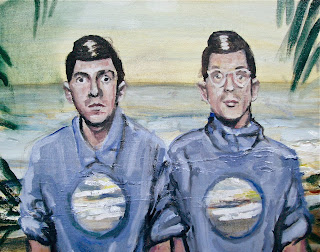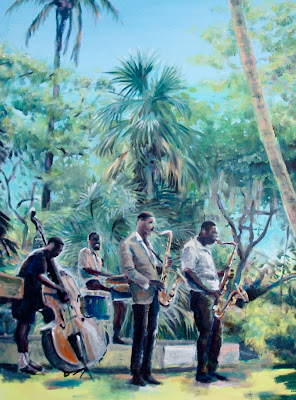 |
| Nagat 12" x 9" oil on canvas board, 2013 |
Nagat El Sagheera (pictured above) is an Egyptian singer I found through my friends at Bodega Pop, the one source to instruct me on the music from the Arabic world, old and new. Nagat is in between, neither old nor new, but a singer unlike I’ve ever heard in older or newer music. In stead of dwelling on this terrific recording of Ana Bashak El Bahr from the album Eyoun el Calb, I’ll talk about some of the techniques I used in painting these portraits. I direct you to Bodega Pop for more on Nagat (and you can listen to her music in the process).
After a series of double portraits I’m back to painting a single performer. Whenever a sort of series within the series happens (and this usually happens accidentally), there’s this urge to continue the trend. In 2006 I made the same attempt to paint all double portraits but then too, I gave up after the idea just didn’t make any sense anymore within the concept of the one hundred paintings. There’s a lot to be said for double portraits, both formally and conceptually, a whole range of ideas waiting to be explored, but I opt now to depart this exploration and leave it for the long term. Another thing the last series of paintings have in common is that the musicians are superimposed on landscape paintings that were made as demos for landscape painting classes I teach. And this, my friends, should continue, as at least three more of such 5 week classes are scheduled over the next few months. In contrast to last year’s, when the paintings were all done plein-air in my backyard. The new paintings are random Florida landscapes, and not as precious as the backyard ones. They are less planned out compared to last year’s. I randomly use these backgrounds as if they were blank canvases. You probably noticed that the landscape in the painting above was turned sideways. This also is the result of the randomness I treat the backgrounds with. For Nagat’s I simply chose to flip the landscape format of the demo into a portrait format. The choice is of course a formal one, but what does it mean conceptually? What does it do, for example, to my mantra “as it is above, so it is below?” Two halves of the composition exist side by side, rather than on top of one another. Except maybe in non-representational painting, or in diptychs, you don’t see this orientation much in two dimensional art. Sure the old Egyptians would paint trees sideways but they didn’t use the concept of the horizon. A concept abandoned again in the shift to non-representational painting that happened in the 20th century. In a parallel universe there’s no orientation. (Let’s leave it at that.)
And, by the way,….HAPPY NEW YEAR!



































